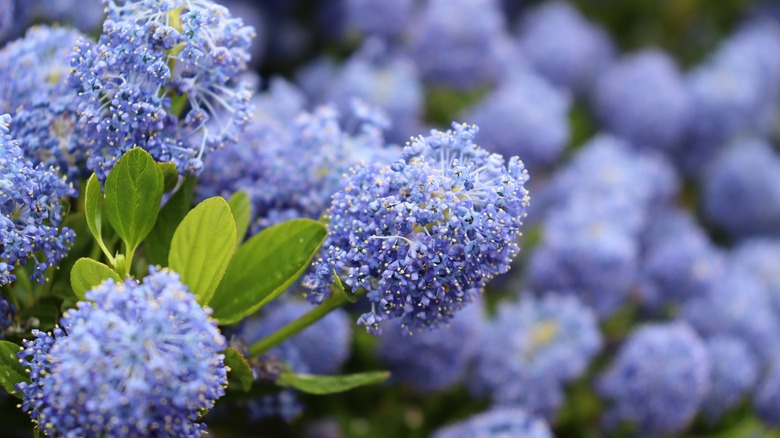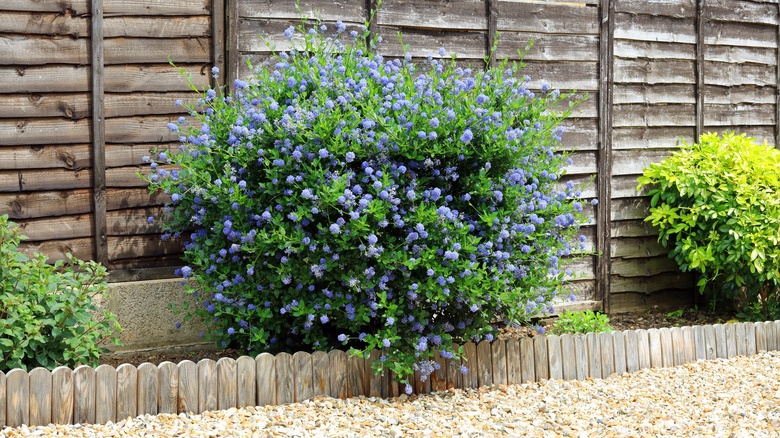The Beautiful Blue Tree That Brings Life To Dry Climates
If you live in a drought-prone region, you know what it's like to deal with water use restrictions during the dry season, and ballooning water bills any time you get to irrigate your garden. Under such conditions, you may think that cacti and succulents are the only plants that will tolerate your yard. But that's not the case. The California lilac is a lush green plant you'd expect to see in the cool, moist reaches of the Pacific Northwest — and yet it thrives with little maintenance in the hot, and often dry conditions of USDA zones 7 through 10.
The crucial aesthetic feature of the California lilac (Ceanothus gloriosus) is its inflorescence, which is made up of tiny, elegant blooms sitting on a thick stem. These flowers are generally bright blue, which earns the plants its "California lavender" moniker. Their luxuriant appearance alone can galvanize a water-wise yard that has little color otherwise. Even when the blooming season is done, these lilacs continue to dazzle with green oval-shaped, shiny, leathery leaves that feature teeth along their edge and fuzzy hair on the underside. Caring for these plants is simple, and they have few natural enemies apart from root rot — which you can avert with proper drainage. Best of all, these lilacs can come handy in your home's defense against wildfires. Find out how to plant and care for these astonishing, drought-tolerant beauties below.
Where to grow California lilac in your yard
The California lilac has three intriguing attributes to help you decide on its ideal location. Firstly, it grows wide, with a spread as vast as 10 feet across. At a height of under 3 feet, this makes the California lilac an excellent ground cover plant — one that you can shape any way you like, too. Secondly, its blooms are quite striking and full of color, so this lilac is an apt choice if you're looking for an accent plant. Finally, if you live in the wildland-urban interface and your home is vulnerable to wildfires, the California lilac makes a suitable candidate for the defensible space — a barrier between your home and the approaching flames. Thanks to its fire-resistance, you can plant the California lilac around the perimeter of your property as a wildfire barrier.
Apart from the strategic and fire safety factors, you should take into account this lilac's preferred habitat. Ceanothus loves full sun, and needs lots of it to grow vigorously. So, choose a bright spot in your yard that gets at least six hours of direct sunlight daily. As for soil, these plants prefer a poorer substrate, but you must make sure that doesn't accumulate water during irrigation or rainfall. California lilacs do not tolerate a soggy, nutrient-rich habitat. If the soil in your yard does not drain well naturally, consider growing this plant in a properly sized raised garden bed.
How to plant and care for the California lilac
Once you've picked a growing location, go ahead and dig a hole for the new plants. The hole should be double the size of the root in width, but the top of the root should protrude above the substrate surface just a bit. While this Ceanothus variety does not require much attention once it matures, young plantings will need a bit of care on your part. So, after planting the lilacs, give them a good, generous watering. You can help preserve moisture in the soil by covering the surrounding surface with mulch and compost — just stay clear of the young trunks when you do so. Since California lilacs are nitrogen-fixing plants, they won't require additional fertilizer. That said, you can stimulate their nitrogen production by adding some mycorrhizal inoculum to the substrate.
For the rest of their first season, continue to nourish the plants with plenty of water regularly. Once they mature and their plants are strong enough, the lilacs no longer need frequent irrigation — even in the summer months. As long as they get plenty of sun, your California lilacs will grow as much as 2 feet per year, blooming in the spring and attracting pollinators to your yard. To keep these plants looking their best, you can prune them at the end of the blooming season.


